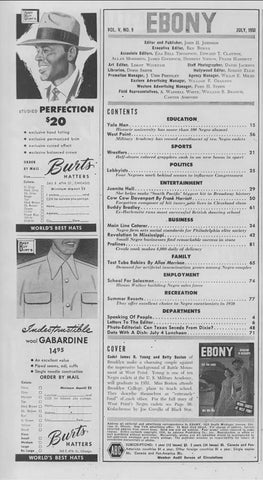
Navigating Style: Black Men and 1950s Fashion Trends
Share
In the 1950s, Black men's fashion was shaped by a rich blend of influences, reflecting individuality, cultural pride, and resilience. This era was marked by a dynamic fashion landscape that drew inspiration from magazines, the entertainment industry, music, and community traditions. Despite the societal challenges of the time, Black men’s fashion became a powerful expression of identity and creativity.
Magazines and Media as Style Guides

Magazines like Ebony and Jet played a pivotal role in shaping fashion trends within the African American community. These publications, tailored specifically for Black audiences, featured fashion spreads and articles that showcased the latest styles. Through their pages, Black men could find inspiration for sophisticated and sharp attire that emphasized both elegance and individuality.
At the same time, movies and television gave rise to African American actors and entertainers who became style icons. Their fashion choices resonated widely, not only within the Black community but also beyond, cementing their status as trendsetters.
Music and the Influence of Jazz and Rhythm and Blues
The music scene of the 1950s, particularly jazz and rhythm and blues, was another significant driver of fashion trends. Musicians like Miles Davis and Duke Ellington were not only celebrated for their talent but also admired for their impeccable sense of style. Davis’s sleek suits and Ellington’s polished ensembles set a standard for sophistication, inspiring fans to emulate their looks.
Music venues and jazz clubs became showcases for cutting-edge fashion, where audiences could admire the sartorial elegance of performers and patrons alike. The fusion of music and style created a powerful synergy that shaped the cultural fabric of the time.
Tailors, Community, and Personal Connections
Local tailors and neighborhood clothing stores played an essential role in Black men’s fashion during this era. Custom pieces and tailored modifications allowed individuals to stay current with trends while ensuring their clothing reflected personal preferences and body types. Tailors often blended contemporary styles with traditional craftsmanship, creating unique garments that stood out.
Community events, church functions, and social gatherings also served as platforms for displaying personal style. These occasions fostered the exchange of fashion ideas and solidified the importance of dressing well as a reflection of pride and dignity. Word of mouth and personal connections further enriched this ecosystem, as individuals shared recommendations for the best tailors, stores, and accessories.
A Reflection of Resilience and Identity
The fashion choices of Black men in the 1950s were more than just expressions of personal style—they were acts of cultural pride and resilience. Each carefully chosen ensemble told a story of creativity and self-expression, defying societal expectations and embracing individuality. Through their clothing, Black men of the era crafted a sartorial narrative that celebrated their heritage and affirmed their presence in a world that often sought to marginalize them.
From the tailored suits inspired by jazz icons to the pages of Ebony and Jet, the fashion of Black men in the 1950s remains a testament to the power of style as a vehicle for identity, pride, and cultural expression.
